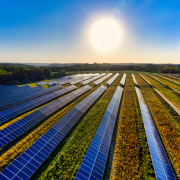AgriSolar News Roundup: NYPA Agrisolar Study Results, Cornell Agrisolar Research, New Solar Panels Increase Crop Yield
NYPA Study Provides Best Practices for Agrivoltaic Systems
“The New York Power Authority (NYPA) announced the release of a new report, Agrivoltaic Leading Practices, that recommends proven and innovative approaches on integrating dual-land use for agriculture and solar energy production. The study determined that a best practice agrivoltaic site ideally involves stakeholder collaboration, community education, policy incentives, site safety practices, and site-individualized crop selection and solar-array design.
Researchers who authored the new report examined how native vegetation, pollinators, low maintenance plants, agricultural crops as well as grazing livestock can coexist on the same parcel of land as a solar energy project.” – The Mountain Eagle
Research Shows Crops and Solar Panels Benefit from Co-Existence
In the threatening trouble of climate change, growing commercial crops on solar farms is a potentially efficient use of agricultural land that can both increase commercial food production and improve solar panel performance and longevity, according to new Cornell research.
“’We now have, for the first time, a physics-based tool to estimate the costs and benefits of co-locating solar panels and commercial agriculture from the perspective of increased power conversion efficiency and solar-panel longevity,’ said lead author Henry Williams, a doctoral student in Cornell Engineering.” – Cornell Chronicle
New Solar Panels Harness Full Light Spectrum and Increase Crop Yields
“According to a new study from the University of California, the blue part of the light spectrum is the most efficient for solar energy production, while the red part is better for plant growth and crop yield. Now, scientists are investigating how harnessing the sun’s complete light spectrum can improve agrivoltaic system’s effectiveness in arid agricultural areas.” – Horti Daily



